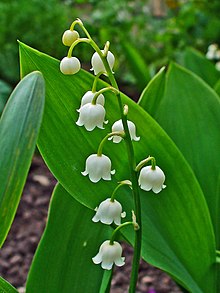Azetidine-2-carboxylic acid
| Structural formula | |||||||||||||||||||
|---|---|---|---|---|---|---|---|---|---|---|---|---|---|---|---|---|---|---|---|

|
|||||||||||||||||||
| ( S ) -azetidine-2-carboxylic acid (left) and ( R ) -azetidine-2-carboxylic acid (right) | |||||||||||||||||||
| General | |||||||||||||||||||
| Surname | Azetidine-2-carboxylic acid | ||||||||||||||||||
| other names |
|
||||||||||||||||||
| Molecular formula | C 4 H 7 NO 2 | ||||||||||||||||||
| Brief description |
beige solid |
||||||||||||||||||
| External identifiers / databases | |||||||||||||||||||
|
|||||||||||||||||||
| properties | |||||||||||||||||||
| Molar mass | 101.10 g mol −1 | ||||||||||||||||||
| Physical state |
firmly |
||||||||||||||||||
| Melting point |
217 ° C |
||||||||||||||||||
| solubility |
5% in water |
||||||||||||||||||
| safety instructions | |||||||||||||||||||
|
|||||||||||||||||||
| Toxicological data | |||||||||||||||||||
| As far as possible and customary, SI units are used. Unless otherwise noted, the data given apply to standard conditions . | |||||||||||||||||||
( S ) -Azetidine-2-carboxylic acid is a non-canonical α-amino acid from the group of azetidinecarboxylic acids , which differs from its analogue, the proteinogenic amino acid L - proline [( S ) -proline] only by being reduced in size by a methylene group. It is a toxic component of the rhizome of native lily of the valley and has an inhibitory effect on plant growth. The azetidine-2-carboxylic acid has a stereogenic center and is therefore chiral . There are two enantiomers: ( S ) -azetidine-2-carboxylic acid and ( R ) -azetidine-2-carboxylic acid. The latter is of little importance.
Natural occurrence
In addition to the parent substance ( S ) -azetidine-2-carboxylic acid [synonym: L- azetidine-2-carboxylic acid] in lily of the valley ( Convallaria majalis ) and in small quantities in sugar beets , their derivatives occur in nature: mugineic acid serves as a phytosiderophore and Nicotinamine is found in soy sauce .
Toxic effect on predators
If predators ( herbivores ) consume the lily of the valley and thus the poison, ( S ) -azetidine-2-carboxylic acid instead of ( S ) -proline [synonym: L -proline] is incorporated into the predator's protein biosynthesis. As a result, the tertiary structure of newly synthesized proteins changes, so that their biological activity is unsuitable or even toxic.
The lily of the valley itself can avoid the uncontrolled incorporation of ( S ) -azetidine-2-carboxylic acid [synonym: L -azetidine-2-carboxylic acid] into its own proteins due to a highly specific prolyl-tRNA synthetase .
Synthesis and application
Several syntheses for ( S ) -azetidine-2-carboxylic acid and the racemate are described in the literature. In general, azetidines can be obtained by reducing β-lactams. Derivatives of azetidine carboxylic acid are used as drugs ( ABT-594 as a non-opioid analgesic ), as pesticides and as catalysts . The synthesis and use of ( S ) -azetidine-2-carboxylic acid derivatives as catalysts in the enantioselective borane reduction of prochiral ketones is described in the literature.
See also
Individual evidence
- ↑ a b c d data sheet L-Azetidine-2-carboxylic acid, ≥99% from Sigma-Aldrich , accessed on December 25, 2019 ( PDF ).
- ↑ a b Data sheet (S) - (-) - 2-Azetidinecarboxylic acid (PDF) from Fisher Scientific , accessed on February 13, 2014.
- ↑ Francoise Couty and Gwilherm Evano: Azetidines-2-carboxylic acid. From lily of the valley to key pharmaceuticals. A jubilee review , Organic Preparations and Procedures International 38 (2006), p. 427.
- ↑ a b Zin Sig Kim: Asymmetrical synthesis of 1,3-amino alcohols and their application for the synthesis of azetidines and 1-azabicyclics (PDF; 1.1 MB), TH Aachen , dissertation, 2006.
- ^ DS Seigler: Plant secondary metabolism. Verlag Springer, 1998, ISBN 0-412-01981-7 , p. 222.
- ↑ M. Miyoshi, H. Sugano, T. Fujii, T. Ishihara and N. Yoneda: A Novel Synthesis of Optically Active Azetidine-2-carboxylic Acid , in: Chem. Lett. , 1973 , pp. 5-6.
- ↑ S. Hanessian, N. Bernstein RY Yang, R. Maguire: Asymmetric synthesis of L -azetidine-2-carboxylic acid and 3-substituted congeners - Conformationally constrained analogs of phenylalanine, naphthylalanine, and leucine , in: Bioorganic and Medicinal Chemistry Letters , 1999 , 9 , pp. 1437-1442; doi: 10.1016 / S0960-894X (99) 00218-8 ; PMID 10360752 .
- ↑ Y. Yamada, T. Emori, S. Kinoshit, H. Okada: Synthesis of (±) -Azetidine 2-carboxylic Acid and 2-Pyrrolidinone Derivatives , in: Agricultural and Biological Chemistry , 1973 , 37 , pp. 649-652 .
- ^ W. Behnen, C. Dauelsberg, S. Wallbaum, J. Martens : Enantioselective Catalytic Borane Reductions of Achiral Ketones: Synthesis and Application of new Catalysts prepared from ( S ) - tert -Leucine and ( S ) -Azetidinecarboxylic Acid , in: Synthetic Communication , 1992 , 22 , pp. 2143-2153; doi: 10.1002 / chin.199306056 .


